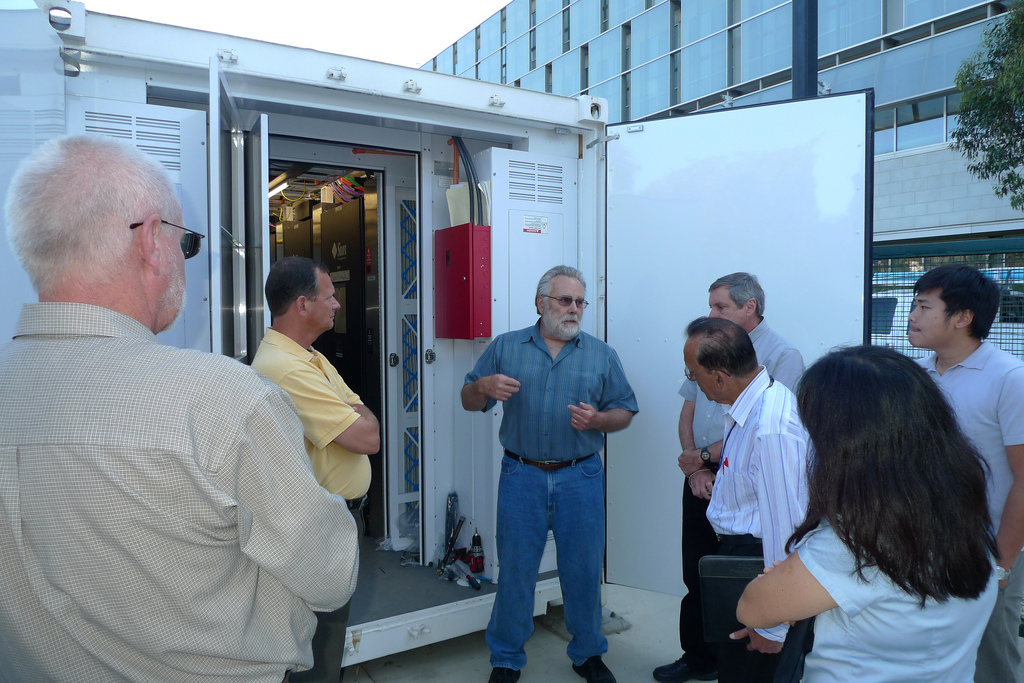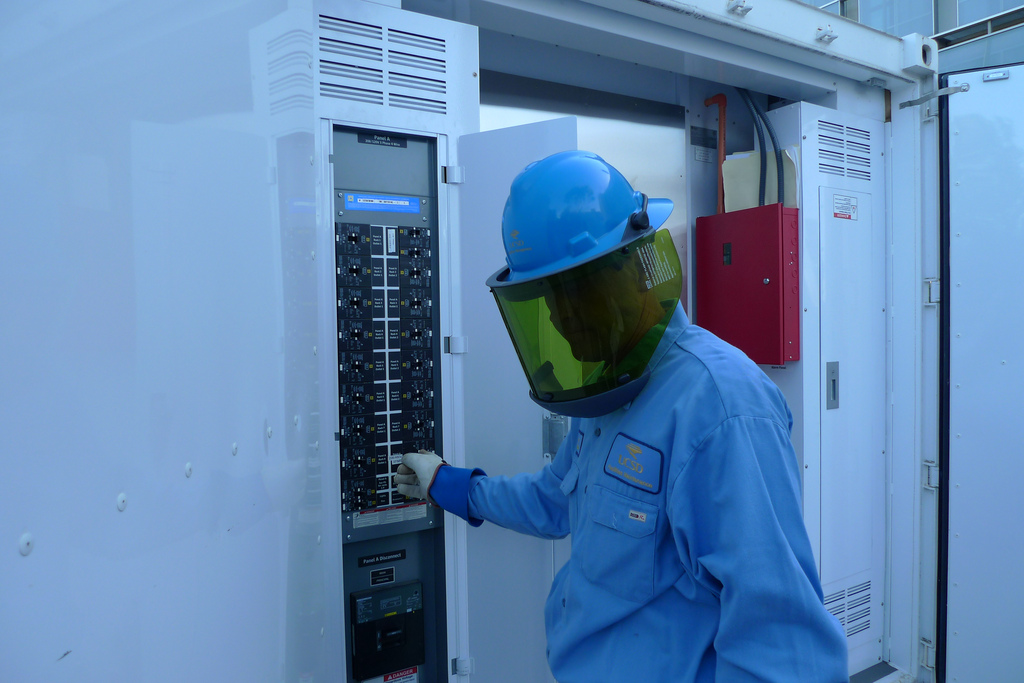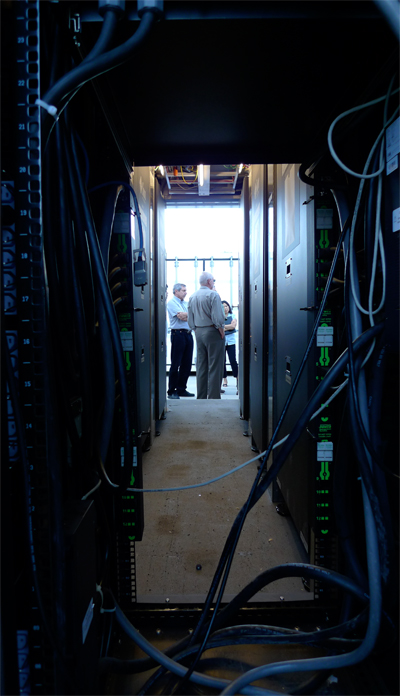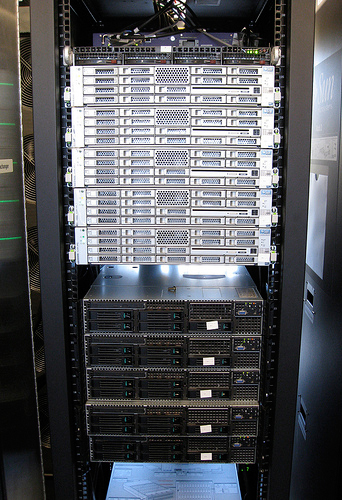Researchers Flip the Switch to Test Energy Saving in Data Centers Using DC Power Directly
San Diego, Aug. 24, 2010 -- A consortium of researchers from the public and private sectors have embarked on a real-world experiment to gauge whether large computing facilities can operate on less power if they cut alternating current (AC) out of the equation.
|
At the University of California, San Diego today, engineers switched a set of servers in a campus data center to operate continuously on 380-volt direct current (DC) – as part of a project that allows researchers to track in great detail the energy savings that servers and data centers can hope to achieve through a variety of architectural and procedural efficiencies, including the use of DC power.
The experiment at UC San Diego is part of Project GreenLight, a National Science Foundation-funded initiative that has deployed a modular data center on campus with sensors and other instruments to measure the energy efficiency of information and communication technologies – and to help researchers build greener IT systems and software.
“The UC San Diego campus has made substantial investments for energy savings,” said Thomas A. DeFanti, principal investigator on Project GreenLight and a senior research scientist in the California Institute for Telecommunications and Information Technology (Calit2). “The switch to DC powering of servers holds great potential on a campus where supercomputers and other high-tech facilities represent a disproportionately large share of energy consumption.”
|
In a traditional server facility AC power is provided at a high voltage and converted to DC in the UPS system to charge batteries and condition the power. From there it is converted back to AC to drive the power supplies of computing equipment to run CPU, memory, disks, and communications components. Skipping or consolidating the above conversion steps can save considerable electricity usage overall in the power distribution chain and in cooling.
“Each conversion loses power and generates additional heat, both of which reduce the overall power and cooling efficiency of the server facility,” said William Tschudi, a DC power researcher at Lawrence Berkeley National Laboratory who has provided technical leadership and represented the California Energy Commission (CEC) Public Interest Energy Research (PIER) program’s involvement with GreenLight’s DC power server experiments. “By providing DC power directly to the server facility, many conversion steps are bypassed and less heat is generated, leading to overall higher efficiency.”
|
The researchers hope to prove that switching to an all-DC power distribution should increase the ‘computing work per watt’ – a key barometer of energy efficiency in computing environments. In addition to significant energy savings, other potential benefits include improved power quality, reduced cooling needs, higher equipment densities, reduced heat-related failures, improved reliability (from fewer components) and ease of use of renewable sources of DC power. The DC power researchers also point out that the industry has the opportunity to make this a worldwide standard through the ongoing collaborative efforts.
|
This is one of the first installations in the United States to utilize system components specifically manufactured for this (380v) DC power system topology. Direct Power Technologies worked with Emerson Network Power to provide the rectifier system; Spectrum Power Management Systems for 380v DC rated plug strips; and Anderson Power Products to provide connectors and cords specifically manufactured for the UCSD project’s system topology.
The server functionality in this dual AC and DC power supply model is independent of ultimate power source, whether it be AC, DC, fossil fuel or renewable energy. Each system is capable of operating in both AC-DC and DC-DC power modes via separate power feeds. By switching two breakers, operators can change the mode of operation from AC to DC.
Distributed energy resources that utilize renewable energy and produce DC power are rapidly growing nationwide. UC San Diego itself has an ambitious program for the deployment for an additional 2 MW of photovoltaic panels, multi-megawatt electricity energy storage systems, and a 2.8 MW fuel cell that utilizes currently flared methane gas from the local wastewater treatment plant.
|
“The DC power project is the first proof-of-concept step towards a larger project that would include renewable energy resources as they become available here at UC San Diego,” said Greg Hidley, a technical director with Project GreenLight. “We envision at the very least the addition of existing campus photovoltaic power and ideally power from the future UCSD fuel cell as well.”
The DC-DC experiment will provide a fully instrumented environment to measure the achievable efficiencies when using DC power at the server, rack and data center levels – and to compare those efficiencies to the energy profile of GreenLight’s existing AC-DC instrument racks. According to Berkeley Lab’s Tschudi, the overall system efficiency of AC systems in data centers is lower, whereas a DC-based powering architecture results in better system efficiency by reducing the number of AC-DC conversions. In the future, further efficiency gains are possible by directly powering variable speed fans, pumps and chillers with DC along with lighting systems. These devices operate on DC today, so the transition to DC would be relatively straightforward.
Many industrial partners cooperated to support this experiment, which is one of the first in the United States using components specifically manufactured for this 380VDC power topology.
Media Contacts
Doug Ramsey, UCSD, 619-379-2912, dramsey@ucsd.edu or Allan Chen, Berkeley Lab, A_Chen@lbl.gov
Related Links
Project GreenLight
Lawrence Berkeley National Laboratory
Oracle Corp.
EPRI
Direct Power Technologies
Delta Electronics
EMerge Alliance
California Energy Commission
UC San Diego Sustainability
DC Power Videos
Emerson Network Power
Intel Corp.
Intel 380VDC Blog
Anderson Power Products
Spectrum Power Management Systems






